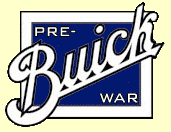One of the most famous concept cars, or styling exercises, was Buick's Y-Job.
 The obvious question was "Why the Y-Job? Why go to all the trouble of creating a prototype that would never go into production?" This experiment in design came about largely at the impetus of a General Motors styling manager -- and eventually vice president at GM -- by the name of Harley Earl. Harley Earl's Y-job represented a whole new approach to automotive design. The obvious question was "Why the Y-Job? Why go to all the trouble of creating a prototype that would never go into production?" This experiment in design came about largely at the impetus of a General Motors styling manager -- and eventually vice president at GM -- by the name of Harley Earl. Harley Earl's Y-job represented a whole new approach to automotive design.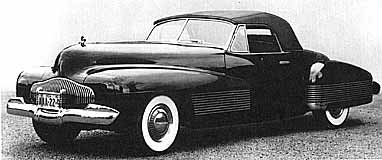 Harley Earl had the fortune of being the son of J.W. Earl, a coach and wagon builder since 1899. The Earl family resided in Los Angeles, California. J.W. Earl's first horse-drawn wagons were sold to local Mexican farmers who used them in their agricultural work in the "valley of smoke" as the Indians called it. But in 1911 the Horsley Brothers rented an abandoned tavern on Sunset Blvd. at Gower and began making moving pictures using actors. According to historian Stephen Bailey, the Earl Automobile Works offered custom-built bodies for cars and trucks to the Hollywood crowd, as well as fuselages for the Glen L. Martin Company, a pioneer in the California aerospace industry. Harley Earl had the fortune of being the son of J.W. Earl, a coach and wagon builder since 1899. The Earl family resided in Los Angeles, California. J.W. Earl's first horse-drawn wagons were sold to local Mexican farmers who used them in their agricultural work in the "valley of smoke" as the Indians called it. But in 1911 the Horsley Brothers rented an abandoned tavern on Sunset Blvd. at Gower and began making moving pictures using actors. According to historian Stephen Bailey, the Earl Automobile Works offered custom-built bodies for cars and trucks to the Hollywood crowd, as well as fuselages for the Glen L. Martin Company, a pioneer in the California aerospace industry.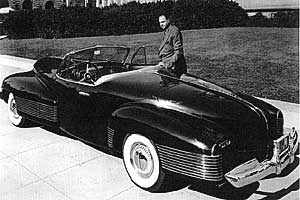 J.W. Earl's designs were known for their sculpted look, and by 1918 the company was building entire vehicles, not just bodies. One of the Earl Company's important customers was Don Lee, a distributor for Cadillac. In 1919 Don Lee bought the Earl Automobile Works. According to General Motors President Alfred P. Sloan's memoirs, Harley Earl was hired as a consultant to the Fisher Cadillac Division in 1926, and was soon put to work designing the new LaSalle, to debut the following March. This new marque, with its "flying wing" fenders and low, long appearance, "...was the first stylist's car to achieve success in mass production," according to Sloan. J.W. Earl's designs were known for their sculpted look, and by 1918 the company was building entire vehicles, not just bodies. One of the Earl Company's important customers was Don Lee, a distributor for Cadillac. In 1919 Don Lee bought the Earl Automobile Works. According to General Motors President Alfred P. Sloan's memoirs, Harley Earl was hired as a consultant to the Fisher Cadillac Division in 1926, and was soon put to work designing the new LaSalle, to debut the following March. This new marque, with its "flying wing" fenders and low, long appearance, "...was the first stylist's car to achieve success in mass production," according to Sloan.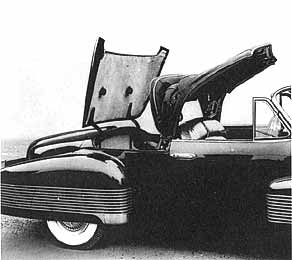 In June of 1927 Alfred Sloan announced that he was creating a special, new department at General Motors. For lack of a better term, he called it "The Art and Colour Section" and placed Harley Earl at its head. The new department started out with fifty people (this was GM after all; eventually it grew to about 1400). Earl's next well-known design was the disastrous "pregnant Buick" of 1929. The engineering and production department had altered the design's proportions. Sloan reacted dryly, "Consumers could be prepared by measured steps for more radical changes in styling." But Earl refused to take blame for the 1929 Buick. In June of 1927 Alfred Sloan announced that he was creating a special, new department at General Motors. For lack of a better term, he called it "The Art and Colour Section" and placed Harley Earl at its head. The new department started out with fifty people (this was GM after all; eventually it grew to about 1400). Earl's next well-known design was the disastrous "pregnant Buick" of 1929. The engineering and production department had altered the design's proportions. Sloan reacted dryly, "Consumers could be prepared by measured steps for more radical changes in styling." But Earl refused to take blame for the 1929 Buick. The Great Depression began the following year, and competition among car builders became intense as each vied for the last dollar that buyers were able to spend on any new motorcar. Pizzazz and flash became the methods of attracting new customers. And so by 1937 Harley Earl, his credentials established, decided to create a "concept car" to test the waters of public opinion and try out some new details and elements as well as gizmos of the most modern automotive design. The Art and Colour Section became The Styling Department.
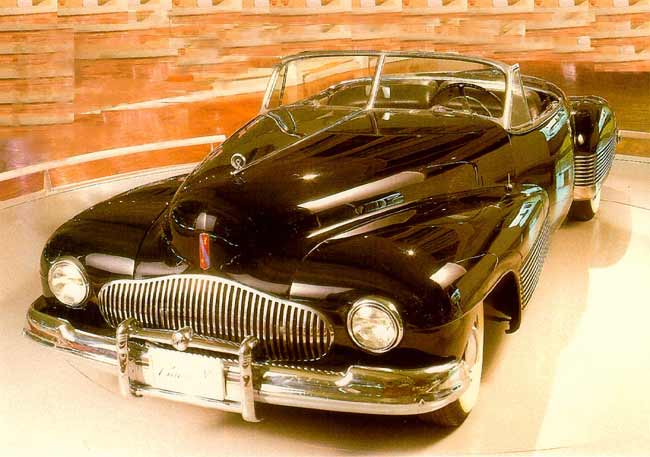 The Y-Job was to be a dream car that would evaluate public taste. As with almost all Harley Earl designs, someone else actually did the drawing -- in this case GM stylist George Snyder. The two-seater sports car was based on a standard Buick chassis, stretched to two inches short of twenty feet, riding on coil springs. The finished car was just 58 inches high -- less than 5 feet! -- at the top of the windshield. The 141 hp of Buick's 320 cid engine was restrained by a braking system that used bladders instead of wheel cylinders.
 The Y-job's streamlined shape echoed elements seen in Chrylser's Airflow design, in its integrated forms and flush seams of the sheet metal. Displaying Buick's first Buick's "bombsight" hood ornament, the car featured electric doors and windows and a hidden, power-operated electric convertible top. Power-operated concealed headlights, "recessed" tail lamps, flush door handles and a pop-out decklid handle, all contributed to the ultra-slippery impression. Running boards were history of course, and bumpers were closely wrapped around the bodywork. GM's first horizontal radiator grille was inspired by the Mercedes W154 Grand Prix racing car. And then-unheard-of thirteen-inch wheels made the car look even longer and lower than it already was. The Y-job's streamlined shape echoed elements seen in Chrylser's Airflow design, in its integrated forms and flush seams of the sheet metal. Displaying Buick's first Buick's "bombsight" hood ornament, the car featured electric doors and windows and a hidden, power-operated electric convertible top. Power-operated concealed headlights, "recessed" tail lamps, flush door handles and a pop-out decklid handle, all contributed to the ultra-slippery impression. Running boards were history of course, and bumpers were closely wrapped around the bodywork. GM's first horizontal radiator grille was inspired by the Mercedes W154 Grand Prix racing car. And then-unheard-of thirteen-inch wheels made the car look even longer and lower than it already was. At a time when car shows did not display 'concept cars," Harley Earl used the Y-Job dream car as his personal transportation and got lots of attention that way. It was shown to the general public after W.W. II.
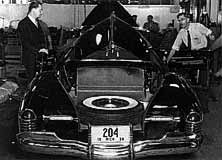 Harley Earl went on to become a vice president of GM. His innovations included the use of full-size clay models. He supervised five car design studios, one for each GM division, as well as twelve special studios. He himself did no design work or drawing; Earl merely prodded his designers and draftsmen to work in certain directions. Harley Earl went on to become a vice president of GM. His innovations included the use of full-size clay models. He supervised five car design studios, one for each GM division, as well as twelve special studios. He himself did no design work or drawing; Earl merely prodded his designers and draftsmen to work in certain directions. Earl had an office called the "hatchery" where his ideas came to him. The room was completely blacked out, without a telephone and had a fictitious name on the door so that he would not be disturbed or interrupted. Author Stephen Bayley noted, "Earl conducted the design process with a mixture of discretion, emotional violence and bizarrerie." He once suggested to executives of US Steel that they should develop a transparent metal. Occasionally, upon making such outlandish suggestions, Earl would look around the room at his design team and state, "If you disagree stand up so we can all get a look at the son of a bitch."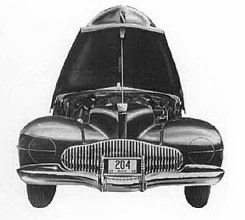
Certain features of the 1937/1938 Buick Y-Job turned up in production cars for the next two decades. However, the first production car with power-operated hidden headlights was the 1937 Cord, so Earl may have been inspired by the radical design of that car. The next production auto to have such headlights was the 1942 DeSoto. The power-operated convertible top that hid in the hinged metal boot was copied later by Ford, so Earl's Y-Job influenced not only GM cars but other makes as well.
After announcing his retirement from GM in December of 1959, Harley Earl concluded his industrial design philosophy this way: "You will never know what the industrial products of the future will be like, but the secret is to keep trying to find out...I'd rather try crossing a river on a path of bobbing soap cakes than make predictions about the car of tomorrow. The footing would be far safer."
Some of the images in this feature were found on a wonderful French specialty-automotive website, MotorLegend. Gilles Bonnafous has done great work in describing GM Dream Cars.
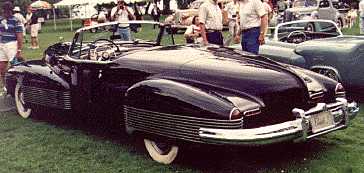 Here's a literal answer to the title question, Why the Y-Job? Why DID they call it that? Simply, most experimental cars were tagged with "X", sometimes along with a name or number, and so just for different Earl decided to use the letter Y. Here's a literal answer to the title question, Why the Y-Job? Why DID they call it that? Simply, most experimental cars were tagged with "X", sometimes along with a name or number, and so just for different Earl decided to use the letter Y. |
